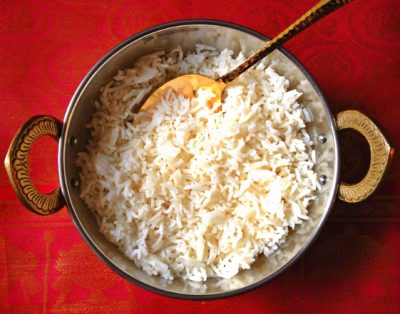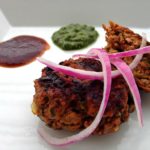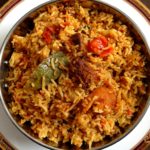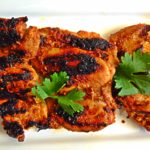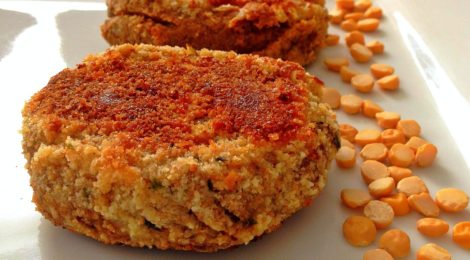
Indian Cooking 401 — Recipe #4: Shammi Kebabs
Indian Cooking 401 – In this lesson you will master a signature kebab from 18th century India: the shammi kebab
Objectives:
-
Learn the art of the Indian kebab with this famous rendition that slow cooks meat and lentils together to produce kebabs that are silky on the inside and crispy on the outside
-
You will use spices like black cumin and mainstays like uncooked channa dal
-
At the 401 level you are becoming a real pro and will have to visit an Indian grocer or specialty store to buy spices (such as black cumin seeds and nigella seeds) that you won’t be able to find easily at your local supermarket
Mughlai cuisine was born out of the Mughal Empire’s rule in India from the 1500s-1800s. In the historical city of Lucknow in India’s state of Uttar Pradesh, the shammi kebab was born. According to the book Curry: A Tale of Cooks & Conquerors, it’s believed that during the rein of Nawab Asaf-ud-Dualah from 1775-1797, his love of food is said to have led to creation of the shammi kebab (also spelled shami kebab). Apparently Nawab Asaf-ud-Dualah had a voracious appetite despite his lack of teeth! The invention of the shammi kebab was thought to have been created just for him — unlike many kebabs you might have eaten, whether they are skewered pieces of boneless meat or minced meat over charcoal, shammi kebabs are made out of finely minced and pounded meat, usually high quality beef or lamb. While the Mughals generally liked minced beef, lamb was often preferred because it produced a softer mince. Good cuts of meat would be ground into a fine paste, spices added, and then the kebabs were roasted over a fire, rendering kebabs that were crispy on the outside and soft and silky on inside that even the Nawab could eat.

The Nawab of Lucknow in the late 1700s was Asaf-ud-Dualah, who unlike other Mughal rulers, was a great foodie and ate so much he couldn’t ride his horse! It’s believed the shammi kebab was created just for him. (Source: Wikipedia)
Today, shammi kebabs are popular in India, Pakistan, Bangladesh, Afghanistan, Iran, and Azerbaijan. In some versions, when forming the kebabs, pieces of raw onion, hardboiled egg, nuts, or raisins are inserted in the center of each patty just before pan-frying. In this recipe, which I’ve modified to make it easy for modern home cooks, boneless beef or sirloin starts off in a big non-stick skillet with onion, garlic, ginger, spices, and uncooked channa dal (chick peas) before it’s transferred to a slow cooker where it thickens into a rich and robust curry for 4 hours on HIGH/8 hours on LOW. After several hours the meat is tender and falling apart and the channa dal is just cooked. Once it cools down a little, you blend the curry into a fine paste that is soft and feathery. The mixture is then formed into small patties, dipped in egg and flour, and then pan-fried. Et voila! The result is the shammi kebab, which has a crispy texture but melts in your mouth. The taste is unlike other kebabs, because the meat has a unique richness and appeal having been twice cooked. I usually serve it with mint chutney and tamarind-date sauce. You can serve it as a snack, appetizer, or main course. Because it’s already cooked, it keeps in the fridge for at least a couple of days.
Shammi Kebabs
Serves 8
Ingredients
- 1/4 cup canola oil
- 1 teaspoon black cumin seeds (shahi jeera)
- 1 large red onion, chopped
- 3 heaping tablespoons ginger-garlic paste
- 1 teaspoon turmeric
- 2 pounds boneless stewing beef or sirloin (you can use boneless leg of lamb if you prefer)
- 1 teaspoon salt
- 1 cup channa daal, uncooked
- 1 teaspoon kashmiri red chilli powder
After meat is cooked
- 1 teaspoon garam masala
- 1 teaspoon cumin powder
- 1 teaspoon coriander powder
- 1 teaspoon red kashmiri chilli powder (adjust to taste)
- 2 teaspoons salt (adjust to taste)
- 1 cup warm water
For frying
- 2 eggs, lightly beaten
- 1 cup breadcrumbs
- Cooking spray
- 2 tablespoons butter or ghee
For serving
- Tamarind sauce
- Mint chutney
- Fresh lime
- Raw onion & green chilli
Preparation
- Soak uncooked channa daal (lentils) in a small bowl with cool water for 1-2 hours to soften them up (add enough water to cover them).
- In a large, non-stick skillet, heat canola oil on medium-high heat. When the oil is ready (sprinkle a few drops of water, which should sizzle), add black cumin seeds and sauté. Add chopped onion and continue sauteeing until they begin to brown. Add ginger-garlic paste (lower the flame a bit as it may splutter when you add it), turmeric, and combine well. Add lamb and brown until the red color starts to disappear. Add salt, then drain the soaked channa daal and add to skillet. Mix well to combine. Add kashmiri red chilli powder. Mix well again.
- Transfer contents of skillet into a slow cooker and set level to HIGH for 4 HOURS.
- Turn off slow cooker; while still in the slow cooker insert, add cumin, coriander, garam masala, and kashmiri red chilli powders. Add salt. Add water and mix to combine well. Transfer to a platter and let cool.
- Using a hand immersion blender, gently blend the mixture, adding a little warm water (1/4 cup at a time) as necessary — the ratio is important here, you don’t want it too tough, and you don’t want it too runny. You want a consistency that’s fine and stringy, similar to a fine tuna fish (see photo below).
- Divide the mixture into quarters and form each quarter into two large patties, and flatten. Dip each patty into beaten egg, then into breadcrumbs. (You can always prepare the patties and keep them in the fridge if you plan to serve them later or the next day; then all you do is dip each in egg and breadcrumbs and pan fry).
- Generously spray your large non-stick skillet with cooking spray on medium heat; add butter or ghee and once it has melted and is glistening (don’t allow to burn), add patties and brown on one side (say 2-3 minutes), then turning on the other side. Remove to platter lined with paper towels and drain.
- Serve immediately with a squeeze of fresh lime, raw onions, tamarind sauce, and mint chutney.
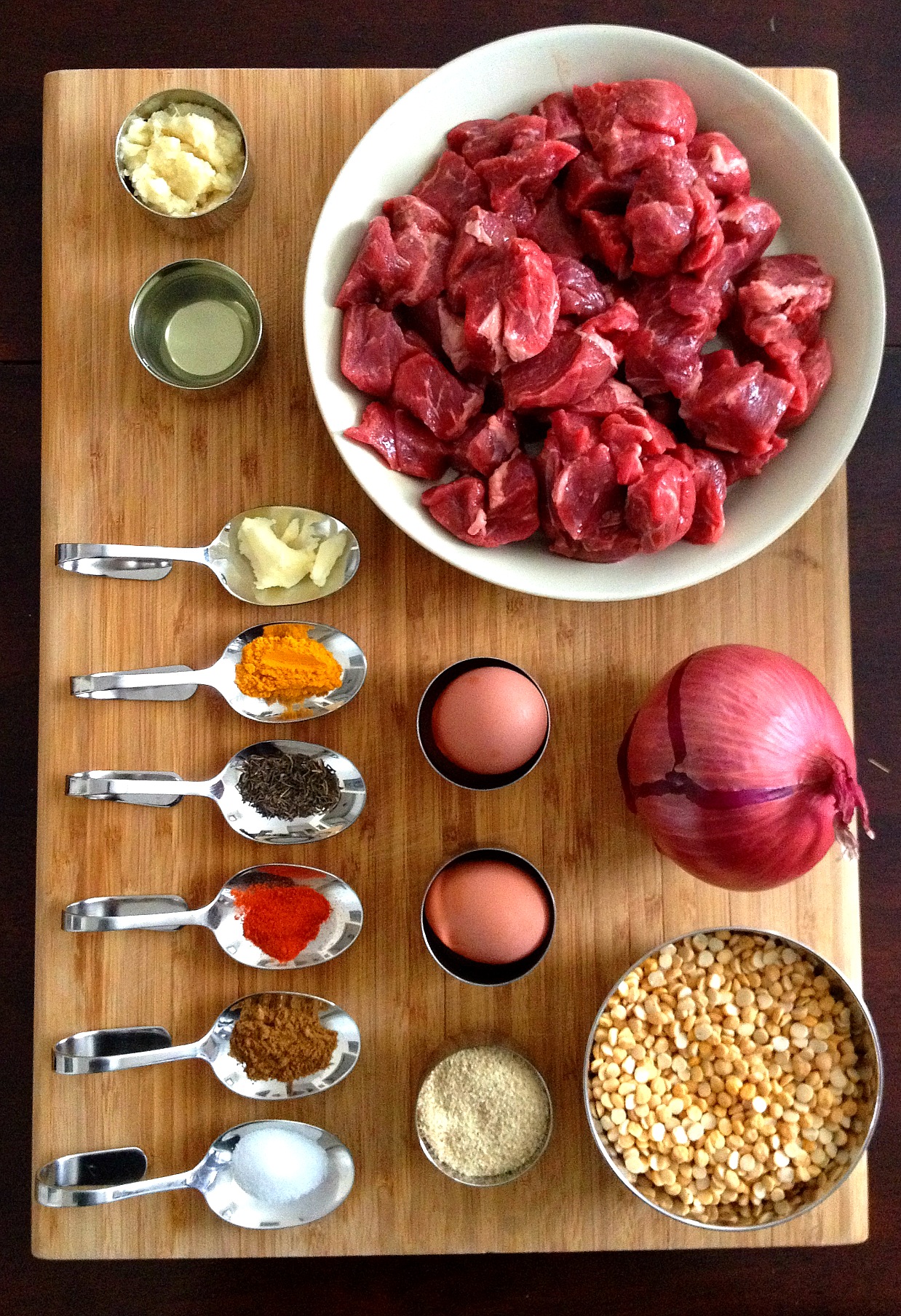
Starting from top left to right: ginger-garlic paste, canola oil, boneless stewing beef, butter, turmeric, black cumin, eggs, red onion, kashmiri red chilli powder, garam masala, salt, breadcrumbs, channa dal (missing are coriander powder and cumin powder)
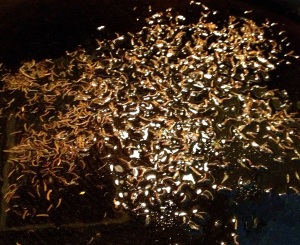
Heat canola oil in non-stick skillet and add black cumin seeds, which are different in look, taste, and smell than cumin seeds

Add onions, ginger-garlic paste, and turmeric
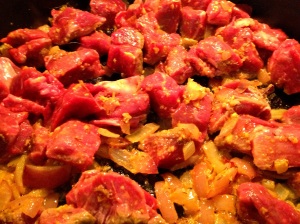
Add boneless stewing beef or sirloin (you can also use lamb, chicken, or turkey) and brown

Add drained channa dal and mix well to combine
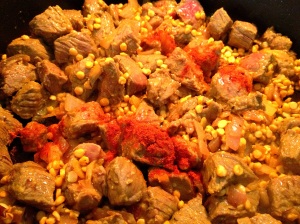
Add red kashmiri chilli powder

Transfer contents of skillet into a slow cooker insert and set for HIGH for 4 HOURS
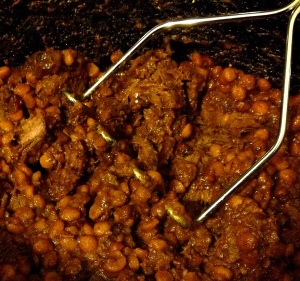
After 3-4 hours give it a good stir and add 1/2 cup of warm water if necessary, and gently mash mixture with a potato masher
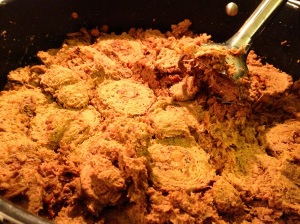
After removing mixture aside to a platter to cool, transfer back into your non-stick skillet, add 1/4 cup of warm water if necessary, and using an immersion hand blender, gently pulse the mixture until it has this silky, feathery-like texture
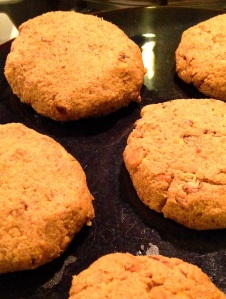
Form into patties and flatten
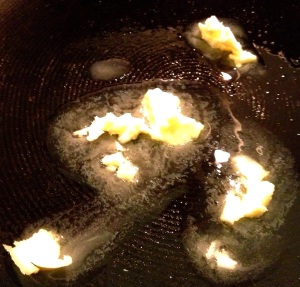
Heat butter or ghee (clarified butter) in non-stick skillet on medium
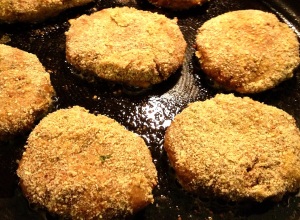
After dipping each patty in beaten egg and then breadcrumbs, pan fry for 2-3 minutes each side
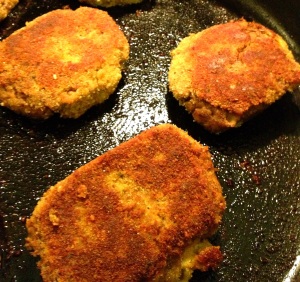
Turn over, each patty should be easy to flip with a spatula — if not, you may need to add a little more canola oil to the skillet; each patty should have this reddish-gold crispy coating

This famous kebab recipe calls for slow cooking boneless meat and lentils together. Result? Kebabs that are silky on the inside and crispy on the outside!
